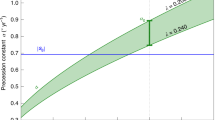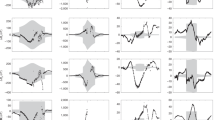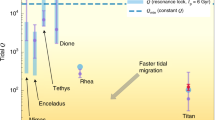Abstract
Io is the volcanically most active body in the Solar System and has a large surface heat flux1,2,3. The geological activity is thought to be the result of tides raised by Jupiter4, but it is not known whether the current tidal heat production is sufficiently high to generate the observed surface heat flow5,6. Io’s tidal heat comes from the orbital energy of the Io–Jupiter system (resulting in orbital acceleration), whereas dissipation of energy in Jupiter causes Io’s orbital motion to decelerate. Here we report a determination of the tidal dissipation in Io and Jupiter through its effect on the orbital motions of the Galilean moons. Our results show that the rate of internal energy dissipation in Io (k2/Q = 0.015 ± 0.003, where k2 is the Love number and Q is the quality factor) is in good agreement with the observed surface heat flow5,6, and suggest that Io is close to thermal equilibrium. Dissipation in Jupiter (k2/Q = (1.102 ± 0.203) × 10-5) is close to the upper bound of its average value expected from the long-term evolution of the system7, and dissipation in extrasolar planets may be higher than presently assumed8. The measured secular accelerations indicate that Io is evolving inwards, towards Jupiter, and that the three innermost Galilean moons (Io, Europa and Ganymede) are evolving out of the exact Laplace resonance.
This is a preview of subscription content, access via your institution
Access options
Subscribe to this journal
Receive 51 print issues and online access
$199.00 per year
only $3.90 per issue
Buy this article
- Purchase on Springer Link
- Instant access to full article PDF
Prices may be subject to local taxes which are calculated during checkout


Similar content being viewed by others
References
Matson, D. L., Ransford, G. A. & Johnson, T. V. Heat flow from Io. J. Geophys. Res. 86, 1664–1672 (1981)
Veeder, G., Matson, D., Johnson, T., Blaney, D. & Goguen, J. Io’s heat flow from infrared radiometry: 1983–1993. J. Geophys. Res. 99, 17095–17162 (1994)
Spencer, J. R. et al. Io’s thermal emission from the Galileo photopolarimeter-radiometer. Science 288, 1198–1201 (2000)
Peale, S. J., Cassen, P. & Reynolds, R. T. Melting of Io by tidal dissipation. Science 203, 892–894 (1979)
McEwen, A. S., Keszthelyi, P., Lopes, R., Schenk, P. M. & Spencer, J. R. in Jupiter: The Planet, Satellites and Magnetosphere (eds Bagenal, F., Dowling, T. E. & McKinnon, W. B.) 307–328 (Cambridge Univ. Press, 2004)
Moore, B., Schubert, G., Anderson, J. D. & Spencer, J. R. in Io After Galileo: A New View of Jupiter’s Volcanic Moon (eds Lopes, R. M. C. & Spencer, J. R.) 89–105 (Springer, 2007)
Yoder, C. F. & Peale, S. The tides of Io. Icarus 47, 1–35 (1981)
Levrard, B. et al. Tidal dissipation within hot Jupiters: a new appraisal. Astron. Astrophys. 462, L5–L8 (2007)
De Sitter, W. Orbital elements determining the longitudes of Jupiter's satellites, derived from observations. Leiden Ann. 16 (2), 1–92 (1928)
Lieske, J. H. Galilean satellite evolution - observational evidence for secular changes in mean motions. Astron. Astrophys. 176, 146–158 (1987)
Segatz, M., Spohn, T., Ross, M. N. & Schubert, G. Tidal dissipation, surface heat flow, and figure of viscoelastic models of Io. Icarus 75, 187–206 (1988)
Ojakangas, G. & Stevenson, D. Episodic volcanism of tidally heated satellites with application to Io. Icarus 66, 341–358 (1986)
Greenberg, R. Galilean satellites - evolutionary paths in deep resonance. Icarus 70, 334–347 (1987)
Fischer, H. J. & Spohn, T. Thermal-orbital histories of viscoelastic models of Io (J1). Icarus 83, 39–65 (1990)
Hussmann, H. & Spohn, T. Thermal-orbital evolution of Io and Europa. Icarus 171, 391–410 (2004)
Moore, W. Tidal heating and convection in Io. J. Geophys. Res. 108 doi: 10.1029/2002JE001943 (2003)
Keszthelyi, L. et al. New estimates for Io eruption temperatures: implications for the interior. Icarus 192, 491–502 (2007)
Moore, W. The thermal state of Io. Icarus 154, 548–550 (2001)
Anderson, J. D., Jacobson, R. A. & Lau, E. L. Io’s gravity field and interior structure. J. Geophys. Res. 106, 32963–32969 (2001)
Gavrilov, S. V. & Zharkov, V. N. Love numbers of the giant planets. Icarus 32, 443–449 (1977)
Ogilvie, G. I. & Lin, D. N. C. Tidal dissipation in rotating giant planets. Astrophys. J. 610, 477–509 (2004)
Wu, Y. Origin of tidal dissipation in Jupiter. II. The value of Q. Astrophys. J. 635, 688–710 (2005)
Yoder, C. F. How tidal heating in Io drives the Galilean orbital resonance locks. Nature 279, 747–770 (1979)
Goldstein, S. J. & Jacobs, K. C. A recalculation of the secular acceleration of Io. Astron. J. 110, 3054–3057 (1995)
Vasundhara, R., Arlot, J.-E. & Descamps, P. in Dynamics, Ephemerides and Astrometry of the Solar System (eds Ferraz-Mello, S., Morando, B. & Arlot, J.-E.) 145–149 (Proc. 172nd Symp. Int. Astron. Union, IAU, 1996)
Aksnes, K. & Franklin, F. A. Secular acceleration of Io derived from mutual satellite events. Astron. J. 122, 2734–2739 (2001)
Stone, R. C. Positions for the outer planets and many of their satellites. V. FASTT observations taken in 2000–2001. Astron. J. 122, 2723–2733 (2001)
Morrison, D. & Telesco, C. M. Io - observational constraints on internal energy and thermophysics of the surface. Icarus 44, 226–233 (1980)
Sinton, W. M. The thermal emission spectrum of Io and a determination of the heat flux from its hot spots. J. Geophys. Res. 86, 3122–3128 (1981)
Johnson, T. V. et al. Volcanic hotspots on Io - stability and longitudinal distribution. Science 226, 134–137 (1984)
Veeder, G. J., Matson, D. L., Johnson, T. V., Davies, A. G. & Blaney, D. L. The polar contribution to the heat flow of Io. Icarus 169, 264–270 (2004)
Rathbun, J. A. et al. Mapping of Io’s thermal radiation by the Galileo photopolarimeter-radiometer (PPR) instrument. Icarus 169, 127–139 (2004)
Lay, T., Hernlund, J. & Bussett, B. A. Core–mantle boundary heat flow. Nature Geosci. 1, 25–32 (2008)
Acknowledgements
We thank D. Pascu for sharing his unpublished observations.
Author Contributions All authors contributed to the writing of the manuscript. V.L. developed and fitted to the observations the full numerical model presented in this work. J.-E.A. fitted to the observations the secular accelerations using L1 astrometric residuals (Supplementary Information). Theoretical calculations of the energy dissipation and Fig. 2 were made by Ö.K. T.V.H. and Ö.K. contributed to the geophysical interpretations of the secular accelerations.
Author information
Authors and Affiliations
Corresponding author
Supplementary information
Supplementary Information
This file provides a detailed description of the dynamical model, a Supplementary Discussion, Supplementary Notes including references, Supplementary Tables 1-5 and Supplementary Figures 1-3 with Legends. (PDF 555 kb)
PowerPoint slides
Rights and permissions
About this article
Cite this article
Lainey, V., Arlot, JE., Karatekin, Ö. et al. Strong tidal dissipation in Io and Jupiter from astrometric observations. Nature 459, 957–959 (2009). https://doi.org/10.1038/nature08108
Received:
Accepted:
Issue Date:
DOI: https://doi.org/10.1038/nature08108
This article is cited by
-
Evidence for lunar tide effects in Earth’s plasmasphere
Nature Physics (2023)
-
Planetary Radio Interferometry and Doppler Experiment (PRIDE) of the JUICE Mission
Space Science Reviews (2023)
-
Investigating Europa’s Habitability with the Europa Clipper
Space Science Reviews (2023)
-
Exploring the Interior of Europa with the Europa Clipper
Space Science Reviews (2023)
-
A comprehensive investigation of the Galilean moon, Io, by tracing mass and energy flows
Experimental Astronomy (2022)
Comments
By submitting a comment you agree to abide by our Terms and Community Guidelines. If you find something abusive or that does not comply with our terms or guidelines please flag it as inappropriate.



